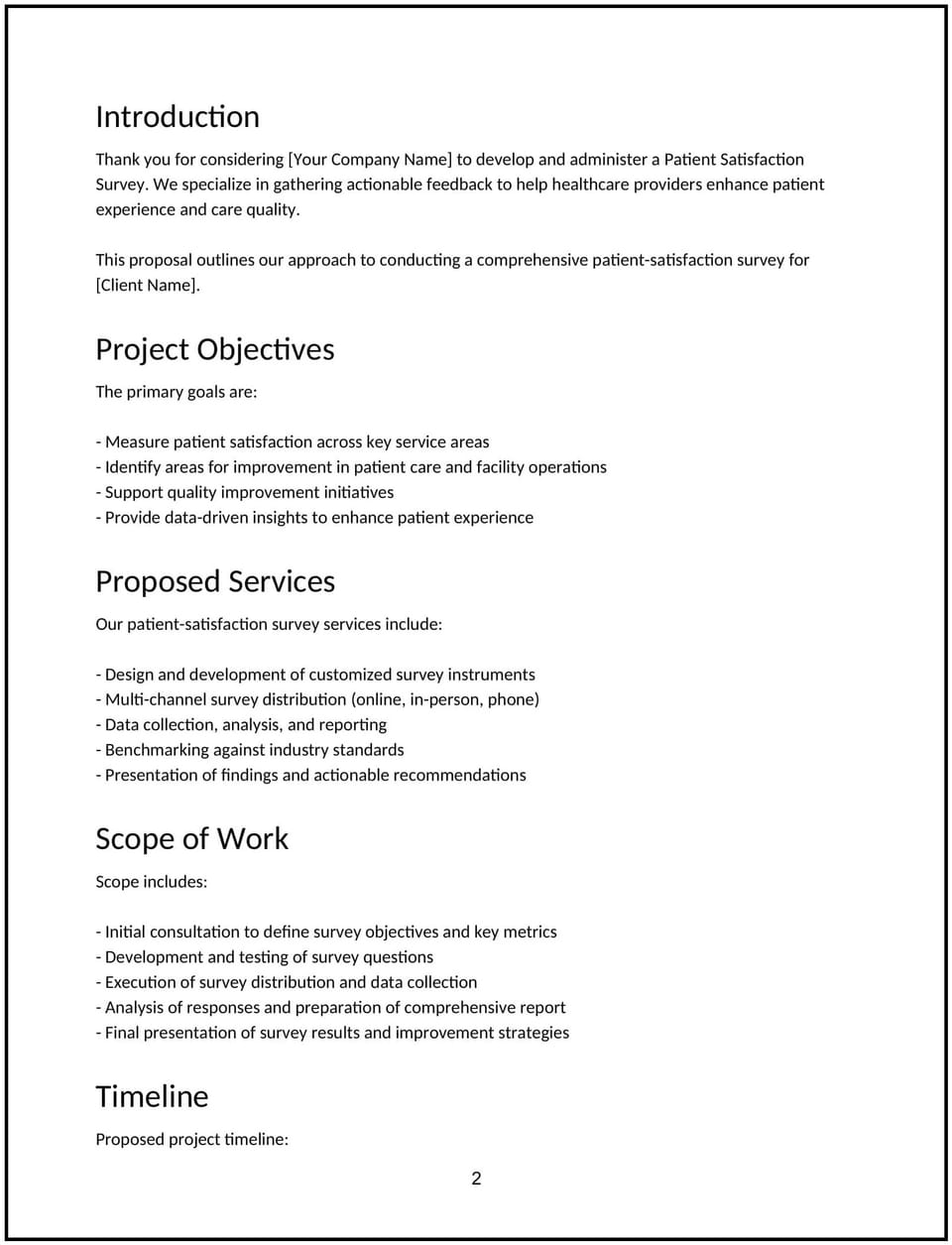Patient-satisfaction survey proposal: Free template

Customize this free patient-satisfaction survey proposal with Cobrief
Open this free patient-satisfaction survey proposal in Cobrief and start editing it instantly using AI. You can adjust the tone, structure, and content based on the healthcare setting, survey method, and reporting needs. You can also use AI to review your draft — spot gaps, tighten language, and improve clarity before sending.
Once you're done, send, download, or save the proposal in one click — no formatting or setup required.
This template is fully customizable and built for real-world use — ideal for pitching feedback and satisfaction survey services to hospitals, clinics, private practices, or health systems. Whether you're gathering routine data or preparing for accreditation, this version gives you a structured head start and removes the guesswork.
What is a patient-satisfaction survey proposal?
A patient-satisfaction survey proposal outlines your plan to gather, analyze, and report on feedback from patients regarding their care experience. It typically includes the survey goals, methodology, delivery method, reporting structure, and implementation timeline.
This type of proposal is commonly used:
- When a provider wants to improve patient experience and service quality
- To meet internal quality benchmarks or regulatory standards
- In preparation for accreditation, reimbursement programs, or marketing efforts
It helps the client understand how structured feedback can lead to better patient outcomes, stronger brand reputation, and improved operational performance.
A strong proposal helps you:
- Align the survey design with the provider’s strategic goals
- Set expectations for delivery, response rates, and reporting cadence
- Demonstrate credibility in healthcare research and feedback handling
- Show how data will translate into action and improvement
Why use Cobrief to edit your proposal
Cobrief makes it fast and simple to create a polished proposal — with smart AI tools and no formatting distractions.
- Edit the proposal directly in your browser: Start customizing without setup or formatting software.
- Rewrite sections with AI: Instantly tailor your tone, simplify jargon, or adjust language based on the client’s audience.
- Run a one-click AI review: Let AI catch vague phrases, missing metrics, or unclear next steps.
- Apply AI suggestions instantly: Accept edits one by one or apply all changes at once.
- Share or export instantly: Send the proposal directly or download a clean PDF or DOCX for delivery.
You’ll spend less time formatting and more time closing deals.
When to use this proposal
Use this patient-satisfaction survey proposal when:
- Quoting survey design, execution, and reporting for healthcare providers
- Responding to a request from hospital administrators or patient experience teams
- Supporting post-visit feedback programs or discharge follow-ups
- Offering survey data analysis as part of a broader quality improvement strategy
- Preparing data for CMS, CAHPS, or internal benchmarking initiatives
It’s especially useful when the provider wants actionable feedback, not just a formality.
What to include in a patient-satisfaction survey proposal
Use this template to walk the client through how you’ll gather and use patient insights to improve care delivery and satisfaction.
- Project overview: Describe the client’s goal — such as improving bedside manner, wait times, communication, or follow-up — and how the survey supports that.
- Survey methodology: Explain the type of survey (e.g., post-visit, periodic, targeted), format (digital, phone, paper), and the timing of delivery.
- Sampling and distribution: Outline how participants will be selected and how surveys will be distributed to maximize response rates.
- Data handling and privacy: Clarify how patient responses will be anonymized, secured, and reported in compliance with HIPAA or other privacy standards.
- Analysis and reporting: Describe how responses will be analyzed, including key metrics, sentiment analysis, or benchmarks against industry standards.
- Insights and recommendations: Explain how findings will be translated into actionable improvements or strategic recommendations.
- Timeline and cadence: Provide a clear schedule for launch, collection, analysis, and reporting — whether one-time or recurring.
- Pricing: Present your fee structure — flat project fee, per response, or monthly retainer. Note any add-ons like dashboard access or custom reporting.
- Next steps: End with a clear CTA — such as confirming scope, sharing survey preferences, or scheduling a kickoff call.
How to write an effective patient-satisfaction survey proposal
This proposal should feel practical, thoughtful, and aligned with real operational goals — not just generic data collection.
- Lead with real-world value: Frame the survey as a driver of care improvement, not just a checkbox for compliance.
- Use familiar language: Make the proposal accessible to both clinical and non-clinical stakeholders.
- Be clear on privacy: Show how patient data is protected and how reporting avoids individual identification.
- Tailor the metrics: Customize questions or benchmarks to the provider’s specialty, service lines, or pain points.
- Reinforce reporting and ROI: Emphasize what they’ll get — usable insights, improved workflows, or better online reputation.
- End with direction: Don’t leave next steps open-ended — offer a clear path to move forward.
Frequently asked questions (FAQs)
Can I reuse this proposal for different healthcare settings?
Yes — just adjust the methodology and language for hospitals, clinics, specialty practices, or urgent care centers.
Does this include CMS or CAHPS-compliant surveys?
It can. If the client needs CMS-aligned formats, you can include CAHPS survey structuring and benchmarks in the scope.
Can I offer real-time dashboards?
Absolutely. If your platform includes dashboards, just include that under reporting and analytics.
What if the client wants recurring surveys?
You can propose a monthly, quarterly, or ongoing cadence and price it accordingly.
Is this proposal a legally binding agreement?
No — this outlines your scope, methods, and pricing. A separate agreement can be attached if needed.
This article contains general legal information and does not contain legal advice. Cobrief is not a law firm or a substitute for an attorney or law firm. The law is complex and changes often. For legal advice, please ask a lawyer.